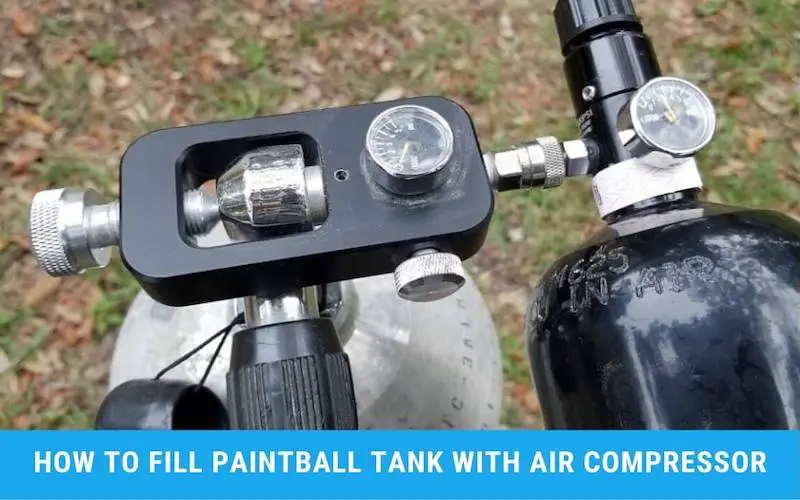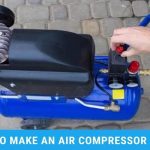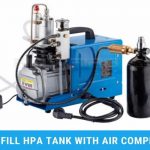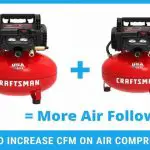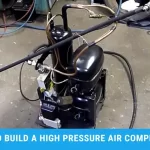Paintball is a sport where players blast paintballs using a paintball gun and compressed air stored in a tank. The compressed air propels pellets from the cannon to their intended targets and if you play frequently, you’ll need to regularly refill your paintball gun tank. So, do you know how to fill paintball tank with air compressor?
Due to CO2, if used too much, it can be expensive. Some sober paintball players prefer to stick their index fingers on a home compressor when practicing target or shooting solo. It can significantly lower the cost but requires an additional component to connect the compressed air tank to the paintball gun.
How To Fill Paintball Tank with Air Compressor: Steps to Action
After years of professional experience in the paintball arena, we have mastered the method of quickly refilling any tank. To fully grasp the procedure, read the entire article.
Filling up your paintball container at home is the quickest, easiest, and most convenient option. The only thing you need to remember is that you should never use the tire compressor to fill up the paintball tank. Let’s explore the steps for adequately refilling your tank at home!
Step 1: Find the maximum PSI of your tank
Before you fill the paintball tank, you need to figure out how much PSI it has. This is frequently noted on the tank. The average capacity is around 4,500 – 5,000 PSI; therefore, be sure you don’t exceed the tank’s capacity.
When filling a CO2 container, you should first chill it to stabilize the temperature. This procedure will assist in quickly filling the tank.
Step 2: Connect to a Fill Nipple now
Examine the attachment attached to the air tank. When an O-ring is fitted to the tank, it should keep air from escaping.
You can’t fill the tank if you can’t find that ring; the air compressor pours air right through, enabling it to run thru the bottom. You must contact someone in this situation.
However, if the O-ring is present, draw back the connection collar to reveal the core needle. Connect it to the tank via its filling nipple. To check that the air hose is tight and firm, wiggle it.
Step 3: Refill the Paintball Tanker Slowly
Once the adapter is installed correctly, carefully release air from your tank. The most excellent air compressor is one with a lever. Simply push that. If it contains buttons, pay close attention to which ones you press and when.
In any case, don’t pull the buttons or press the lever through. You want to load paintball air tanks gently rather than quickly.
The pressure gauge rises as the filling process begins. Remember that the tank should only contain between 3000 – 4500 PSI. Before starting the filling procedure, understand your tank’s requirements.
Step 4: It’s Time to Keep An Eye On The Gauges
When loading your paintball tank, you must focus on two gauges: one on the compressor and one on the gun. It would be beneficial if you attentively monitored both gauges while you refilled the tank, allowing you to double-check the gauge’s operation. In most cases, both gauges must move in the same direction.
Step 5: Avoid a Hot Fill
One error you could make while filling your tank is to do it too soon. This is commonly referred to as a “hot-fill.” When you press the air compressor’s button or lever too hard, air bursts from the compressor and through the tank, causing the gauge to climb swiftly. That is something you don’t want to happen since it might harm your tank or exaggerate its capacity.
A hot fill looks to fill the tank, but the air becomes heated after disconnection, and the gauge slides back down if you’re not using it. To avoid this, the entire process should be carried out gently. Otherwise, you risk having an empty tank 15 minutes after filling it off.
Step 6: Proceed with Caution
After filling the paintball reservoir, some air would remain within the air compressor, ready to be fed into the tank. Frequently people forget this, which might lead to problems later on. You may get rid of the extra air by using the compressor’s release valve.
When you open the valve, all of the excess air escapes. If you do not release pressure before disconnecting the line, you may damage your tank and have to replace it.
Step 7: Disconnect the Hose
Once the pressure has been released, you may separate the air compressor line from the filling nipple. Reverse everything you did before, beginning with the collar. Pull it down to disconnect the air hose from the connection. Then, place the hose on the tabletop and go outside for more fun.
Don’t know if you can fill HPA tank with air compressor? Yes, you can! Check 6 simple steps here.
What are the Different Sizes of Paintball Tanks
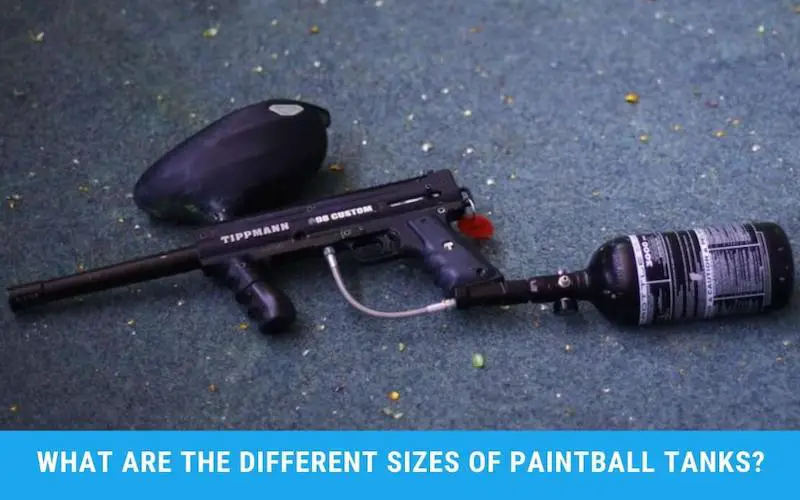
To understand how to use an air compressor to refill a paintball tank, we must first comprehend the various varieties. Paintball tanks are classified into two types.
- Tanks for compressed air.
- Tanks for CO2.
Nitrogen containers are far less standard than CO2 or compressed air tanks. As a result, we won’t have to deal with them, however.
CO2 Storage Tanks
Aluminum and steel are used to make co2 tanks. The sizes of these tanks range from 4 oz to 24 oz. Of course, refilling a CO2 tank with CO2 is preferable.
Any other type of gas may cause your paintball pistol to malfunction. Compressed air is a gas that may be used in various applications. It is possible and safe to refill the CO2 paintball gun using compressed air.
Anyway, I would avoid doing so at all times. CO2 tanks have a pressure rating of 1800 PSI. Air compressors with pressure ratings ranging from 3000 – 4500 PSI. That is more than enough to replenish CO2 paintball tanks.
In general, a CO2 tank is less expensive than an HPA tank, but it also has some drawbacks. The tank must be hot to convert liquid CO2 to gas, around 75°F.
Playing in cold weather will prevent the gas from expanding correctly, causing the tank to drop the pressure and become unstable. Also, CO2 has issues with high firing paces. The faster transformation of liquid to gas cold in the tank causes a severe PSI drop.
Compressed Air Tanks
Compressed air tanks have gained popularity in the 1990s, and they have a rapid-fire rate. These models, also comprehended as nitrogen, N2, or nitro tanks, are available in various sizes, generally from 3,000 to 4,500 psi. Remember that higher pressure ensures more shots.
The main benefit of a compressed air tank is that it is more stable than CO2 when shooting at high speeds. In addition, it is not affected as much by environmental factors such as temperature as it is by CO2, making it a much better choice for outdoor paintballing in colder climates. The disadvantage is its setup cost, which can be significantly higher than the CO2 tanks.

What are The Cautionary Notes While Filling a Paintball Tank
Refilling a paintball tank is a simple-but-careful task. I believe you now understand how to fill a paintball tank using compressed air. However, you should bear a few things in mind for your protection.
Most paintball tanks have a PSI meter that informs you how much air they can hold. Fill no more than the specified/required capacity. Also, when opening the release valve, go slowly. If you open it too quickly, the air within your paintball tank will grow heated and eventually waste.
Loading a paintball container is not difficult if you attentively follow the directions above. However, it is also vital to heed the safety cautions. If the transition is not done with safety precautions in mind, it may leak out from the air. If you see any leakage, do not proceed with the transfer. It might be dangerous. Have a good day playing paintball.
Looking for the best air compressor for spray painting? See detailed review and top picks here.
FAQs
Can you fill a paintball tank with a regular air compressor?
No, you can’t do it with the regular compressors. Generally, a home compressor only reaches about 100 to 150 psi. This pressure is not enough for one shot, even from the lowest meter. You’ll need a minimum of 180 to 250 PSI and a maximum of around 800 to 1100 PSI. If you have a costly diving compressor, 3000 psi or 4500 psi will be OK for paintball if you have the necessary adapters for filling your tank, but a regular home air compressor will not work much.
Can you use compressed air in a paintball gun?
Yes, you can use compressed air with high pressure in the paintball guns, typically between 3,000 and 5,000 psi. The paintball gun balances pressure with a hose-attached regulator for optimum performance. Ensure that you can maintain a higher outlet pressure air receiver, and it will work well. Many compressed air cylinders have very low outlet pressure regulators designed for high-performance electronic indicators. If you have a fixed or adjustable exhaust tank above 600 psi, it will work on most markers rather than CO2.
How much psi should a paintball tank have?
Optimum inlet pressure ranges from 300 to 1200 psi based on the indicator. Generally, compressed air tanks produce around 3,000-4,500 psi. This pressure is adjusted to a lower level of 450-850 psi with the reservoir regulator to activate the paintball. Most high-quality electronic indicators with internal airlines need shallow inlet pressures. Automats’ and some others work well at very high pressures. Most conventional indicators without internal routing work fine between 400 and 800 psi but check with the manufacturer for better performance.
Final Verdict
Understanding how to fill paintball tank with air compressor is simple if you know how to connect the pieces. It will become easier and almost automatic as you grow more accustomed to the procedure.
The basic procedures you must take to fill the paintball tank with an air compressor are thoroughly outlined in this post. It should just take you a few seconds to finish. If you opt to do it on your own, keep safety in mind first. Have fun paint-balling once you’ve done it correctly.
